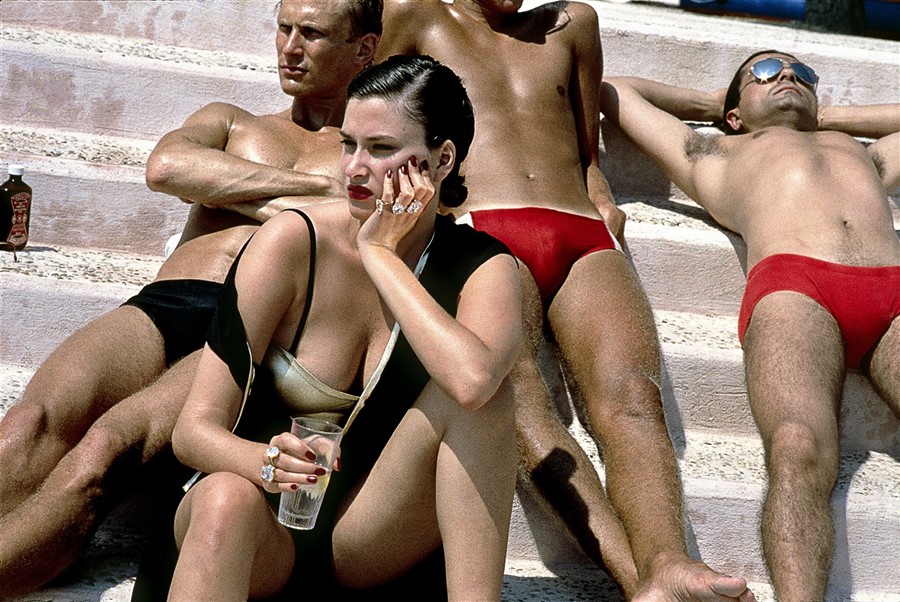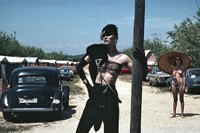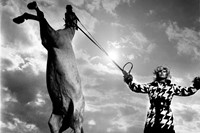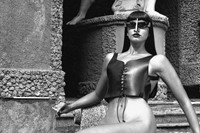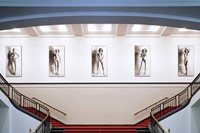The story behind the Helmut Newton Foundation – a "lively building, not a dead museum"
The "Zoo" area of Berlin is known for a few things – of course, the infamous Bahnhof Zoo train station which was the key location in cult classic Christiane F; the Zoological Garden, home to over 1,300 animals; and the Helmut Newton Foundation, founded in 2003 by the photographer himself (he died only a year later). The Foundation is located in a former Prussian officer’s casino called Landwehrkasino, in the Charlottenburg district of Berlin. The dining room in the building was one of Newton's last memories of his hometown – he was forced to leave in 1938, aged 18, due to his family being Jewish. He lived in Singapore, Australia, London and Paris before settling in L.A, the city where he tragically died in 2004, after crashing his car into a wall of the driveway at the notorious Chateau Marmont.
The aim of the Foundation is the conservation, protection and presentation of the photographic oeuvre of Helmut Newton and his wife June. June Newton, who worked from 1970 onwards under the name of Alice Springs, was a prominent portraitist in her own right. Visitors can easily lose hours at the Foundation, exploring Newton's rich body of work, alongside his personal belongings including faxes, passports, props and personal clothing.
Here, AnOther speaks to Matthias Harder, chief curator at the Helmut Newton Foundation in Berlin since 2004, about the story behind the Foundation and his dealings with the legendary photographer.
How and when did you join the Foundation?
I became the Foundation’s curator in spring 2004. I met Helmut and June Newton through a common friend in Berlin in December 2003. Helmut told me about his Foundation which was supposed to be opened in summer 2004 – and at the end of our meeting he asked me if I would like to take over the curator’s position. Of course, I said yes. But I was the director of a Kunstverein nearby Hamburg by then. Therefore, I had to quit this job before I could take on this new challenge.
What is your background?
I studied art history and specialised with a PhD in photo history. After that I curated exhibitions in many cities and countries, edited monographic books and wrote essays on different aspects within the field of photography. I also taught photography when I met Helmut Newton – and I have been doing this until today.
"Helmut's wish was for a "lively building, not a dead museum""
Could you briefly explain what the Foundation is and what its objectives are?
On the occasion of Helmut Newton’s 80th birthday, in 2000, the New National Gallery in Berlin organised a retrospective show of his work. It was the first time that a photographer was exhibited in these 'hallowed halls'. Three years later Newton decided to transfer parts of his archive as well as a permanent loan to his native town of Berlin into his own Foundation. In a public-private-partnership with the Prussian Cultural Heritage, the Museum of Photography was opened with the Helmut Newton Foundation in summer 2004. It is located in an historical building which was designed as a military casino in 1909 and used after WWII as a place for the arts: the Gallery of the 20th Century Art, a precursor of the New National Gallery, furthermore the Berlinische Galerie, which is Berlin’s municipal museum of art, and the Art Library have been located in this building before it was given to Helmut Newton. His wish was for a "lively building, not a dead museum". The Helmut Newton Foundation is now dedicated to the preservation, examination and presentation of the œuvre, of its founder as well of that of his wife June, who has created a significant own body of work since 1970 under the name Alice Springs.
What do you find most interesting about Helmut Newton and his work?
Helmut Newton is one of the legendary figures within the photography world. Thus, it is an honor and a pleasure to work for him – and now for his wife June, who became the president of the Foundation after Helmut's death. I adore some of his iconic and radical works and his timeless elegance. He created an unconventional style that was always on the edge and ahead of the zeitgeist. Newton never ceased to both astound and polarize; he was just a master of all genres – fashion, nude and portrait. He perfectly arranged his models on location, and he subtly played with sex and seduction. Thus, he turned us observers into voyeurs.
Did you ever meet Mr Newton?
Yes, I did but unfortunately just once as he told me about the plans for his Foundation.
What is your favourite exhibit in the permanent collection?
I really like the combination of the exhibits within the permanent display called "Helmut Newton’s Private Property“ which works as a museum within the museum. It includes filmic insights into the creation of Newton’s visual world made by his wife June, along with cameras, accessories and fetish objects used as props by his models. But if you stay in front of the huge poster wall, which features some 100 posters of his exhibitions from 1975 until 2004 as well as commercial ones, you’ll see the enormous impact he had on the history of photography.
What are the future plans for the Foundation?
We will proceed to work with the different aspects of Newton’s outstanding work in hopefully astonishing combinations and juxtapositions. Other photographers will get a forum here as well, according to the wishes of its benefactor. Thus, Newton’s provocative and iconic images will enter into dialogue with the work of other prominent colleagues time and again – like now with Greg Gorman’s portraits of naked men.
The current exhibitions Helmut Newton: Paris-Berlin. Exhibition Grand Palais 2012 and Greg Gorman: Men run until May 18, 2014.
Text by Laura Bradley
